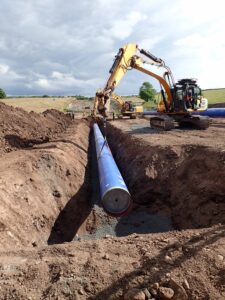Transforming infrastructure – delivering on high hopes
Investment in large-scale infrastructure can unlock economic and social opportunities to transform how we live. David McKillen, Head of Dams and Reservoirs in the UK and Ireland, assesses the benefits transformative projects can deliver and weighs up the challenges they face.
The aim of high-ticket infrastructure projects is to transform a region’s economy and the livelihood of its citizens, with benefits from access to water and electricity to the transport of people and goods. Existing infrastructure also needs to be maintained or updated to cope with changes in demand.
The scale of such projects brings complex challenges, such as environmental concerns, intricate financing, shifting social and demographic needs, stakeholder management and the complications from integrating new schemes with ageing legacy infrastructure.
Challenges versus ambitions
With ambitious plans hoping to deliver improved infrastructure across the island of Ireland, the value they bring to the economy and users must outweigh the risks placed on constraints of budgets, lengthy schedules and managing public scrutiny. To date, projects have had a chequered success rate across the island.
We asked construction professionals across the island of Ireland about the main challenges to the delivery of large infrastructure projects. Our survey showed nearly half citing the government’s lack of planning (46%) or lack of funding (45%). This rose to over to 50 percent for construction professionals in Northern Ireland (NI).
Within NI, the lack of a devolved government has stunted decisions on infrastructure since January 2017. The Institute of Directors estimates political stasis has paused or slowed down up to £2 billion worth of projects.
Despite difficult circumstances, some major projects have maintained momentum across Northern Ireland, such as the Royal Victoria Hospital’s new Maternity Hospital and the A6 Londonderry to Dungiven scheme. AECOM played a key design role in both projects.
Within the Republic of Ireland (RoI) public scrutiny of large infrastructure projects remains high. Whilst crucial in serving the population, hospitals are considered the least well delivered projects according to our survey, largely due to the delays and cost overruns at the National Children’s Hospital in Dublin.
Road and airport delivery ranked as the great successes, with the motorway system across the island cited as having the greatest long-term economic impact. These improved road and motorway networks provide critical connections across regional hubs while also improving public transport links.
Ambitious plans
Project Ireland 2040 is the Republic of Ireland government’s long-term overarching strategy for making integrated infrastructure investment decisions. Project Ireland 2040 has an ambitious aim for balanced regional development across the country, with population expected to increase by 1 million people over the next two decades. Twenty-five per cent of this growth is anticipated for Dublin.
However, like many modern cities, Dublin’s infrastructure is struggling to cope with ballooning population demand and the stresses this adds to current systems. In anticipation of this growth, the National Development Plan (NDP) is a 10-year strategy to invest €115 billion in upgrading infrastructure across roads, ports, rail and aviation to increase accessibility across Ireland’s key cities.
As society changes and grow, demands on infrastructure are altered with some assets requiring an overhaul.
As part of Project Ireland 2040, plans are progressing to develop public transport networks through the BusConnects and DART expansion programmes, and the MetroLink – all providing greater connections across the Dublin region to cope with a growing and aging population.
The water industry in ROI is one sector looking at a step change in approach, requiring substantial investment into both large projects and smaller initiatives that work to improve the bigger picture.
Niall Gleeson, Managing Director of Irish Water comments, “Irish Water is committed to protecting the environment and supporting Ireland’s social and economic growth through appropriate investment in water services. We are delivering a very significant capital investment programme, in the next few years, to improve the quality of water and wastewater services, future-proof the supply and improve resilience, conserve water supplies and tackle leakage.”
He continues, “Our investment is in programmes like the National Leakage Reduction Programme, which will involve an investment of €500m in this programme over four years to tackle a significant leakage problem. Equally important is the investment in standalone projects, like the €400 million staged upgrade of Ringsend Wastewater Treatment Plant and the Cork Lower Harbour Project which will stop the discharge of the equivalent of 40,000 wheelie bins of raw sewage into Cork Harbour.”
“We attach great importance to ensuring that our investment policies are aligned to the national strategic outcomes outlined in the National Development Plan (2018–2027) and to the wider infrastructure policy of Government.”
Within aviation, Dublin Airport has seen rapid growth since 2013, jumping from 20 million passengers a year to 31.5 million. However, the growth of the airport is not over yet, with a €2.5 billion major capital investment programme planned, those passenger numbers are set to grow to over 40 million a year.
With a strategic focus on the construction of MetroLink, a high-capacity, high-frequency rail line, passenger journey times to and from the airport will improve, while also easing internal congestion in the airport itself.
AECOM has been working with daa on a variety of projects for the airport to help it operate efficiently and grow sustainably. Most recently, as lead consultant and technical advisor, we defined the Capital Investment Programme (CIP) 2020-2024 for the Commission for Aviation Regulation (CAR), comprising recommendations for infrastructure development and provided high level design, construction sequencing and cost planning for key elements of infrastructure including terminals, piers, airfield, surface access, drainage and utilities.
Case study: National Water Networks Improvements, Scotland

Across the world, the water industry is facing a myriad of challenges, from climate change and population growth, to ageing infrastructure and tougher regulations. Irish Water knows these challenges only too well as Niall Gleeson, Irish Water MD confirms, “Ireland’s water services are severely stressed and do not meet the country’s needs, which means we have to prioritise our investment decisions to ensure that we use the funds available to deliver infrastructure which will have the biggest benefit to communities and businesses and safeguard the environment”.
It has been progressing a 25-year strategy to achieve a more sustainable and secure drinking water supply, while managing leakages, efficient wastewater treatment and environmental protection to better cope with demand, both now and into the future.
Scotland has been tackling some of the same issues, and its strategic, long-term planning with partners offers a good example.
From programme and commercial management to engineering design and construction, Caledonia Water Alliance (CWA) — a partnership between AECOM and Morrison Utility Services— is designing and delivering the rehabilitation and replacement of Scotland’s entire national water network. This includes new assets, renewals, modifications, maintenance and refurbishment of water networks and pumping stations – an investment of £360 million between 2015 and 2021.
As part of this partnership, AECOM has been involved in numerous water network interventions including capital maintenance, water quality, network enhancements and improvements in overall resilience of Scottish Water’s water supply network all aimed at achieving world class customer service for Scottish Water.
AECOM has deployed 170 employees to the CWA providing a range of technical services from civil and geotechnical engineering to network modelling and dam design, while also employing apprentices and graduates throughout the programme giving opportunities to young people.
In recognition of the effectiveness of this arrangement, Scottish Water renewed the contract and expanded the scope of services of our Alliance to cover 2021-2027. We will continue to deliver all clean water infrastructure for Scotland, with the expansion now delivering wastewater infrastructure work. This will likely add £100m per annum investment into the future of Scotland’s water infrastructure.
Our experience in managing complex, long-term, multi-project programmes allows us to work with clients to help validate their overall strategy, establish design and construction standards, oversee the work of project delivery firms, and manage performance issues concerning budget, schedule and stakeholder concerns. Additionally, our global perspective and knowledge-sharing abilities allow us to apply innovative thinking across the infrastructure industry, with our teams always looking for new ways to solve complex engineering, environmental and construction challenges.
Thinking ahead to support ambitions
As well as pressure to achieve desired technical and economic returns, one of the biggest challenges for major projects is delivering on ambition and how to create the social value for communities. With a long history of delivering large and complex infrastructure schemes globally, AECOM invests in three major areas to help ensure we can play a key role in supporting the infrastructure sector reach it’s potential, deliver our clients’ ambitions and meet public expectations.
 Maintaining public trust: Holding strong relationships across the island’s public sector and supply chains forms an integral part of the AECOM approach, in helping clients achieve ambitious infrastructure objectives. With public sector spending comes an increased social responsibility to ensure transparency at every stage of a project. Ensuring costs and timings are diligently managed is paramount in this process, as is embracing longer-term views of strategic investment to create legacies for future generations. Collaborative conversations across the sector with stakeholders can increase confidence in the value of infrastructure investment and instil a sense of ownership to all.
Maintaining public trust: Holding strong relationships across the island’s public sector and supply chains forms an integral part of the AECOM approach, in helping clients achieve ambitious infrastructure objectives. With public sector spending comes an increased social responsibility to ensure transparency at every stage of a project. Ensuring costs and timings are diligently managed is paramount in this process, as is embracing longer-term views of strategic investment to create legacies for future generations. Collaborative conversations across the sector with stakeholders can increase confidence in the value of infrastructure investment and instil a sense of ownership to all.
 Investing in our people: We bring together a combination of skillsets and experience, perspectives and proficiencies. Bringing talent together under one roof helps efficiently manage project risks, increase innovation and value, and ensure return on investment is maximised. New infrastructure projects have a vast array of objectives extending to climate change mitigation, technological advancement and cross border regulation. Having an array of specialisms working together seamlessly allows for a more favourable outcome.
Investing in our people: We bring together a combination of skillsets and experience, perspectives and proficiencies. Bringing talent together under one roof helps efficiently manage project risks, increase innovation and value, and ensure return on investment is maximised. New infrastructure projects have a vast array of objectives extending to climate change mitigation, technological advancement and cross border regulation. Having an array of specialisms working together seamlessly allows for a more favourable outcome.
 Maximising integration: Across all current and future infrastructure plans, there is the necessity to maximise return on investment and exceed public expectations. However, to achieve this, different infrastructure sectors need to partner in order to understand the whole picture encompassed within these transformative projects. With diligent planning, expert design, efficient delivery, and importantly, informed operational phases, the benefits of transformative projects can extend across the island’s infrastructure in its entirety and continue across the project’s lifetime. Embracing new technology throughout design, construction and operations can also vastly improve integration and efficiency across the lifecycle, while offering better transparency into cost and risk implications.
Maximising integration: Across all current and future infrastructure plans, there is the necessity to maximise return on investment and exceed public expectations. However, to achieve this, different infrastructure sectors need to partner in order to understand the whole picture encompassed within these transformative projects. With diligent planning, expert design, efficient delivery, and importantly, informed operational phases, the benefits of transformative projects can extend across the island’s infrastructure in its entirety and continue across the project’s lifetime. Embracing new technology throughout design, construction and operations can also vastly improve integration and efficiency across the lifecycle, while offering better transparency into cost and risk implications.
By actively evolving to meet the challenges that these large-scale infrastructure projects present, we will strive to transform their challenging perception into a positive economic and social reality for the island.







